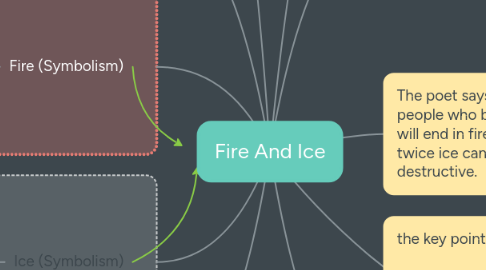
1. Theme-If we don't control our actions and emotions,one day it is going to lead us our doom.
1.1. Tone-Serious
2. Fire (Symbolism)
2.1. Desire
2.2. Greed
2.3. Selifishness
2.4. Anger/Rage
3. Ice (Symbolism)
3.1. Hatred
3.2. Indifference
3.3. Envy
3.4. Intolerance
4. Symbolism/Personfication
4.1. Fire (Quick End)
4.2. Ice (Slow Poison)
5. Stanza And Their Meanings
5.1. Stanza 1: "Some say the world will end in fire, Some say in ice. From what I’ve tasted of desire I hold with those who favor fire."
5.1.1. In the first stanza, the speaker gives two different opinions on how the world could end: some believe that it will end in fire (symbolizing intense passion and desire), and others believe that it will end in ice (symbolizing coldness and hatred). The speaker gives their opinion, that as far as they have been familiar with desire, they subscribe to the belief that fire (desire) would be the reason for the world's destruction. This stanza establishes the metaphor of fire and ice as representations of strong human emotions.
5.2. Stanza 2: "But if it had to perish twice, I think I know enough of hate To say that for destruction ice Is also great And would suffice."
5.2.1. In the second stanza, the speaker fantasizes about a second scenario for the end of the world. If the world were to "perish twice," they propose that hate (represented by ice) might also be capable of destruction. The speaker asserts that they know enough about hate to realize that it, too, is strong enough to end the world. In this instance, the metaphor of ice symbolizes the cold, destructive power of hate, as opposed to the hot, passionate power of desire.
6. Written By Robert Frost
6.1. A romantic poet
7. Poetic Devices
7.1. Rhyme Scheme
7.1.1. 1st Stanza-abaa
7.1.2. 2nd Stanza-bcbcb
7.2. Alliteration
7.2.1. World will
7.2.2. Favour fire
7.3. Anaphora
7.3.1. "Some Say" in 1st and 2nd line
7.4. Enjambment
7.4.1. Both the stanzas are an example of enjambment since the idea continues onto the next line without any punctuation marks.
7.5. Assonance
7.5.1. Sound of "o" in hold with those
